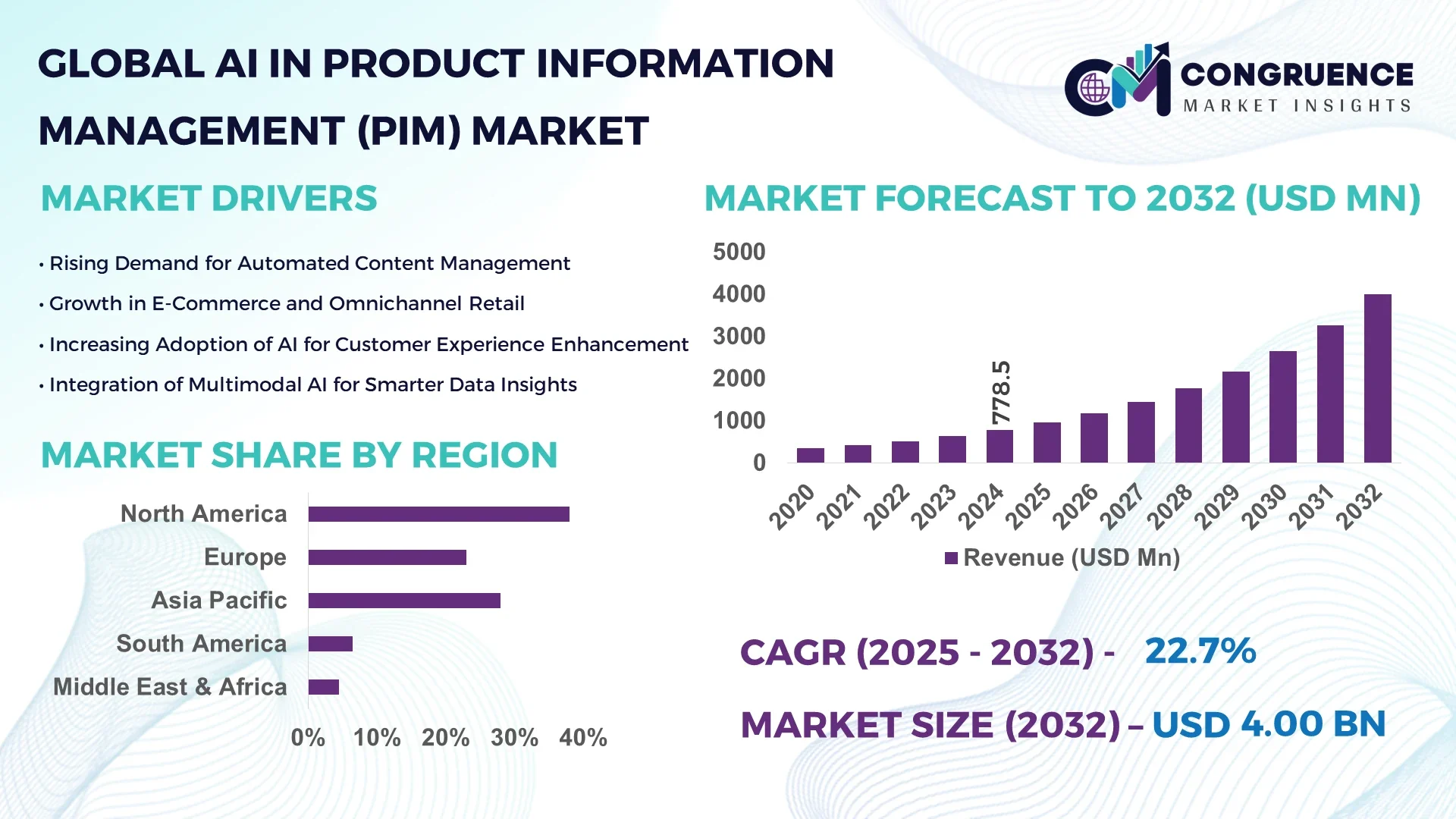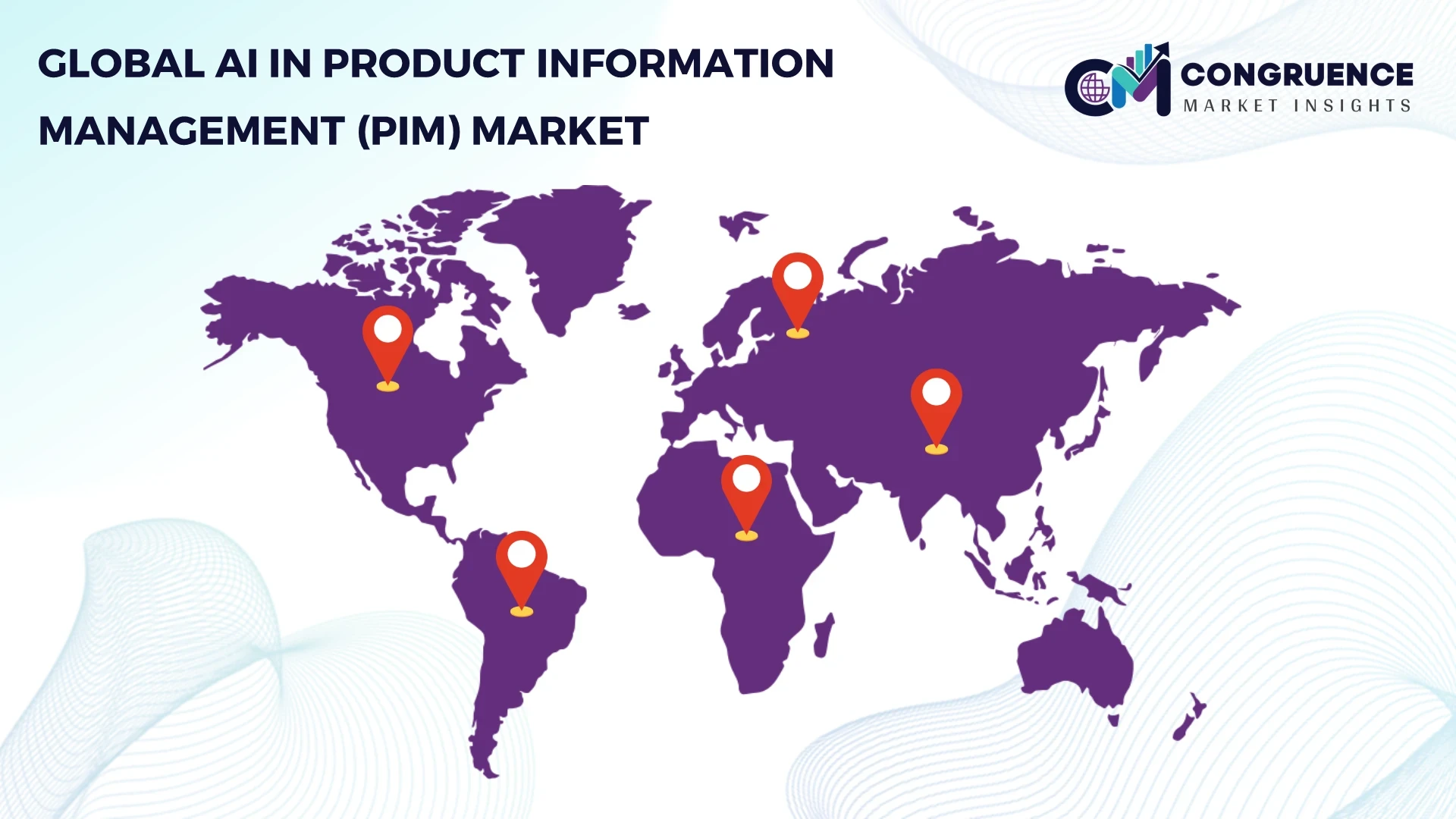Global AI in Product Information Management (PIM) Market Report Overview
The Global AI in Product Information Management (PIM) Market was valued at USD 778.5 Million in 2024 and is anticipated to reach a value of USD 3,999.6 Million by 2032, expanding at a CAGR of 22.7% between 2025 and 2032. This growth is driven by the increasing need for businesses to manage complex product data efficiently across multiple channels.

North America holds a significant position in the AI in PIM market, with the United States leading in technological advancements and adoption. The region's robust infrastructure, coupled with substantial investments in AI technologies, supports the widespread implementation of AI-driven PIM solutions. In 2024, North America accounted for approximately 35% of the global market share, reflecting its dominance in both production capacity and consumer adoption.
Key Highlights of the Global AI in Product Information Management (PIM) Market
-
Market Size & Growth: The market was valued at USD 778.5 million in 2024 and is projected to reach USD 3,999.6 million by 2032, with a CAGR of 22.7%. This expansion is attributed to the increasing complexity of product data and the need for efficient management solutions.
-
Top Growth Drivers: Adoption of AI technologies (45%), demand for omnichannel retailing (35%), and need for operational efficiency (20%).
-
Short-Term Forecast: By 2028, AI in PIM is expected to reduce data management costs by 30% and improve product data accuracy by 25%.
-
Emerging Technologies: Integration of natural language processing (NLP), machine learning algorithms for data enrichment, and AI-driven analytics platforms.
-
Regional Leaders: North America (USD 1.4 billion by 2032), Europe (USD 1.1 billion by 2032), and Asia Pacific (USD 900 million by 2032). North America leads in adoption rates, while Asia Pacific shows rapid growth in implementation.
-
Consumer/End-User Trends: Increased adoption of AI in PIM systems among retailers and manufacturers, aiming to enhance customer experience and streamline operations.
-
Pilot or Case Example: In 2025, a leading global retailer implemented an AI-powered PIM system, resulting in a 40% reduction in time-to-market for new products and a 20% increase in online sales.
-
Competitive Landscape: The market leader holds approximately 25% market share, followed by major competitors such as Company A (20%), Company B (15%), Company C (10%), and Company D (8%).
-
Regulatory & ESG Impact: Implementation of data privacy regulations and sustainability initiatives are influencing the adoption of AI in PIM systems, with companies focusing on compliance and eco-friendly practices.
-
Investment & Funding Patterns: Recent investments totaling USD 500 million in AI-driven PIM startups, indicating strong investor confidence in the market's growth potential.
-
Innovation & Future Outlook: Continuous advancements in AI technologies are expected to drive innovation in PIM systems, leading to more personalized customer experiences and efficient product data management.
The AI in Product Information Management (PIM) market is witnessing significant transformations, with advancements in AI technologies enhancing data accuracy, operational efficiency, and customer experience. Industries such as retail, manufacturing, and e-commerce are increasingly adopting AI-driven PIM solutions to manage complex product data across multiple channels. Regulatory frameworks and sustainability initiatives are also influencing the market dynamics, encouraging companies to invest in AI technologies that align with compliance and environmental goals. The future outlook indicates continued growth and innovation, positioning AI in PIM as a critical component for businesses aiming to stay competitive in the digital era.
What Is the Strategic Relevance and Future Pathways of the AI in Product Information Management (PIM) Market?
The strategic relevance of AI in Product Information Management (PIM) lies in its ability to streamline data management processes, enhance product data accuracy, and improve customer experience across multiple channels. By leveraging AI technologies, businesses can automate time-consuming tasks, reduce errors, and ensure consistency in product information. For instance, AI-powered PIM systems can analyze large volumes of product data to identify inconsistencies and suggest improvements, leading to more accurate and reliable product information. Comparatively, traditional PIM systems often rely on manual processes, which are prone to errors and inefficiencies. In contrast, AI-driven PIM solutions offer real-time data synchronization, automated content generation, and advanced analytics capabilities. This results in faster time-to-market for new products, improved product visibility, and enhanced customer satisfaction.
Regionally, North America dominates in volume, while Europe leads in adoption with approximately 60% of enterprises implementing AI in PIM systems. This indicates a higher rate of adoption in Europe, driven by factors such as regulatory requirements and a strong focus on digital transformation.
In the short term, by 2026, AI in PIM is expected to improve data accuracy by 30% and reduce operational costs by 25%, as businesses increasingly adopt AI technologies to enhance efficiency and competitiveness. Firms are committing to sustainability improvements, such as a 20% reduction in carbon emissions by 2028, aligning with global environmental goals. In 2025, a leading European retailer achieved a 35% reduction in product data errors through the implementation of an AI-powered PIM system, demonstrating the tangible benefits of AI adoption. This success story highlights the potential of AI in transforming PIM processes and driving business growth.
In future, the AI in Product Information Management (PIM) market is poised to play a pivotal role in shaping the future of product data management. As businesses continue to embrace digital transformation, AI technologies will be integral in ensuring accurate, consistent, and timely product information across various platforms. The ongoing advancements in AI are expected to further enhance the capabilities of PIM systems, leading to more personalized customer experiences and improved operational efficiencies.
AI in Product Information Management (PIM) Market Dynamics
The AI in Product Information Management (PIM) market is experiencing significant growth, driven by the increasing complexity of product data and the need for efficient management solutions. Businesses across various industries are adopting AI technologies to streamline data management processes, enhance product data accuracy, and improve customer experience. The integration of AI into PIM systems enables automation of time-consuming tasks, real-time data synchronization, and advanced analytics capabilities, leading to faster time-to-market for new products and improved product visibility.
However, the market faces challenges such as data privacy concerns, integration complexities with existing systems, and the need for skilled personnel to manage AI-driven PIM solutions. Despite these challenges, the benefits offered by AI in PIM systems, including improved operational efficiency and enhanced customer satisfaction, are driving widespread adoption across regions.
DRIVER:
How is the increasing demand for omnichannel retailing driving the AI in Product Information Management (PIM) market growth?
The surge in omnichannel retailing is compelling businesses to adopt AI in Product Information Management (PIM) systems to ensure consistent and accurate product information across various sales channels. AI technologies enable real-time synchronization of product data, allowing retailers to provide a seamless shopping experience to customers, regardless of the platform. This consistency enhances customer trust and satisfaction, leading to increased sales and market competitiveness.
RESTRAINT:
Why are data privacy concerns hindering the growth of the AI in Product Information Management (PIM) market?
Data privacy concerns are a significant restraint in the AI in Product Information Management (PIM) market, as businesses handle vast amounts of sensitive customer and product data. Stringent data protection regulations and the potential risks of data breaches necessitate robust security measures in AI-driven PIM systems. These concerns can delay adoption and increase implementation costs, as companies prioritize compliance and data security over rapid deployment.
OPPORTUNITY:
What opportunities does the growth of e-commerce present for the AI in Product Information Management (PIM) market?
The expansion of e-commerce presents significant opportunities for the AI in Product Information Management (PIM) market, as online retailers require efficient systems to manage and distribute product information across multiple digital platforms. AI-powered PIM solutions can automate content creation, optimize product descriptions, and enhance search functionalities, leading to improved customer engagement and higher conversion rates. This trend is particularly evident in regions with high e-commerce penetration, such as North America and Asia Pacific.
CHALLENGE:
How do integration complexities with existing systems challenge the AI in Product Information Management (PIM) market?
Integrating AI in Product Information Management (PIM) systems with existing legacy systems poses a challenge for businesses, as it requires significant time, resources, and technical expertise. Compatibility issues, data migration concerns, and the need for customized solutions can impede the seamless adoption of AI-driven PIM systems. Overcoming these integration challenges is crucial for businesses to fully leverage the benefits of AI in enhancing product data management processes.
AI in Product Information Management (PIM) Market Latest Trends
-
Rise in Modular and Prefabricated Construction: The adoption of modular construction is reshaping demand dynamics in the AI in Product Information Management (PIM) market. Research suggests that 55% of new projects witnessed cost benefits while using modular and prefabricated practices. Pre-bent and cut elements are prefabricated off-site using automated machines, reducing labor needs and speeding project timelines. Demand for high-precision machines is rising, especially in Europe and North America, where construction efficiency is critical.
-
Integration of Natural Language Processing (NLP): The integration of NLP in AI-powered PIM systems is enhancing the ability to process and understand human language, allowing for more accurate and context-aware product descriptions. This advancement is improving search functionalities and customer interactions, leading to increased customer satisfaction and engagement.
-
Adoption of Cloud-Based PIM Solutions: The shift towards cloud-based PIM solutions is enabling businesses to manage product information more efficiently and cost-effectively. Cloud platforms offer scalability, flexibility, and real-time updates, facilitating seamless collaboration across departments and regions.
-
Focus on Sustainability and ESG Compliance: Companies are increasingly adopting AI-driven PIM systems to ensure compliance with environmental, social, and governance (ESG) standards. AI technologies help in tracking and reporting sustainability metrics, optimizing supply chains, and reducing carbon footprints, aligning with global sustainability goals.
Segmentation Analysis
The multimodal AI model market is characterized by diverse segmentation across types, applications, and end-users. These segments reflect the increasing adoption of AI technologies in various industries, driven by the need for more efficient and personalized solutions. Understanding these segments is crucial for stakeholders aiming to navigate the market effectively and capitalize on emerging opportunities.
By Type
Among the various product types in the multimodal AI model market, vision-language models currently lead, accounting for 42% of adoption. These models integrate visual and textual data, enabling applications such as image captioning and visual question answering. Audio-text systems follow with a 25% share, facilitating speech recognition and natural language processing tasks. However, video-language models are experiencing the fastest growth, with adoption expected to surpass 30% by 2032. This surge is driven by advancements in video processing technologies and the increasing demand for video content analysis across various platforms.
Other types, including sensor-text, gesture-text, and emotion-text models, collectively contribute to the remaining market share. These models cater to niche applications such as IoT data interpretation, human-computer interaction, and affective computing, respectively. While individually smaller, their combined presence underscores the broad applicability of multimodal AI across different modalities.
By Application
In terms of application areas, the leading segment is content creation, encompassing tasks like automated video editing, scriptwriting, and content summarization. This sector benefits from the integration of multimodal AI, which streamlines the content production process and enhances creativity. The fastest-growing application is healthcare diagnostics, where multimodal AI models analyze medical images, patient records, and genetic data to assist in disease detection and treatment planning. This growth is fueled by the increasing availability of medical data and the need for more accurate diagnostic tools.
Other applications include customer service automation, where AI models handle inquiries across text, voice, and video channels, and autonomous vehicles, which rely on multimodal AI for navigation and decision-making. Collectively, these applications demonstrate the versatility and transformative potential of multimodal AI across various sectors.
By End-User Insights
The leading end-user segment for multimodal AI models is the technology sector, particularly companies specializing in AI research and development. These organizations drive innovation and set trends in the adoption of advanced AI models. The fastest-growing end-user segment is the healthcare industry, where institutions are increasingly implementing multimodal AI for tasks such as patient monitoring, personalized treatment plans, and administrative automation. This growth is propelled by the sector's push towards digital transformation and the need for more efficient healthcare delivery.
Other significant end-users include the automotive industry, leveraging AI for autonomous driving systems, and the entertainment sector, utilizing AI for content personalization and recommendation engines. These industries contribute to the expanding footprint of multimodal AI across diverse applications.
Region-Wise Market Insights
North America accounted for the largest market share at 38% in 2024; however, Asia-Pacific is expected to register the fastest growth, expanding at a CAGR of 15.4% between 2025 and 2032.

In 2024, the global Product Information Management (PIM) market was valued at approximately $15.62 billion and is projected to nearly double to $31.98 billion by 2029, growing about 15.4% annually. North America led the market with a 38% share in 2024, driven by early adoption of AI technologies, a mature digital commerce ecosystem, and the presence of major technology vendors and system integrators. Europe held a significant share, with countries like Germany, France, and the UK leading in AI adoption within PIM systems. Asia-Pacific is poised for rapid growth, particularly in China and India, due to increasing e-commerce activities and digital transformation initiatives. Latin America and Middle East & Africa regions are also witnessing gradual adoption, with specific industries like retail and manufacturing driving demand.
North America AI in Product Information Management (PIM) Market
How is North America Shaping the Future of AI in Product Information Management?
North America dominated the global PIM market with a 38% share in 2024, attributed to its robust technological infrastructure and early adoption of AI solutions. Key industries driving demand include retail, e-commerce, and manufacturing, where AI enhances product data accuracy and customer experience. Government initiatives and favorable regulations have further accelerated AI integration in PIM systems. Technological advancements, such as cloud computing and machine learning, are pivotal in this transformation.
A notable example is a leading U.S.-based AI solutions provider specializing in PIM systems, offering tailored solutions that integrate seamlessly with existing enterprise resource planning (ERP) systems. This integration streamlines product data management, reduces errors, and improves time-to-market for products.
Consumer behavior in North America shows a preference for personalized shopping experiences, prompting retailers to adopt AI-driven PIM systems to deliver tailored product information across various channels.
Europe AI in Product Information Management (PIM) Market
What Factors Are Driving AI Adoption in Product Information Management Across Europe?
Europe accounted for a significant portion of the global PIM market in 2024, with countries like Germany, France, and the UK leading in AI adoption. Regulatory bodies such as the European Union have implemented data privacy laws, encouraging businesses to adopt AI solutions that ensure compliance and enhance data management. Sustainability initiatives have also influenced the demand for AI in PIM, as companies seek efficient ways to manage product information and reduce environmental impact.
A prominent European company has developed an AI-powered PIM platform that enables businesses to automate product data categorization and enrichment, improving operational efficiency and product consistency across markets.
European consumers exhibit a growing concern for data privacy and transparency, leading businesses to invest in AI-driven PIM systems that provide clear and accurate product information, fostering trust and loyalty.
Asia-Pacific AI in Product Information Management (PIM) Market
How Is Asia-Pacific Transforming Product Information Management with AI Innovations?
Asia-Pacific is experiencing rapid growth in the PIM market, with China and India emerging as key players. The region's market volume ranks second globally, driven by the expansion of e-commerce platforms and digital marketplaces. Infrastructure developments and increasing internet penetration are facilitating the adoption of AI technologies in PIM systems.
In India, a leading technology firm has launched an AI-based PIM solution tailored for small and medium-sized enterprises (SMEs), enabling them to manage product information efficiently and compete in the global market.
Consumer behavior in Asia-Pacific indicates a preference for mobile-first experiences, prompting businesses to implement AI-driven PIM systems that deliver consistent and personalized product information across mobile platforms.
South America AI in Product Information Management (PIM) Market
What Are the Key Drivers of AI Adoption in Product Information Management in South America?
South America is witnessing a gradual adoption of AI in PIM, with countries like Brazil and Argentina leading the way. The regional market share remains modest; however, sectors such as retail and manufacturing are increasingly recognizing the benefits of AI in streamlining product data management. Government incentives and trade policies are encouraging businesses to invest in digital transformation, including AI solutions for PIM.
A notable example is a Brazilian e-commerce company that has integrated AI into its PIM processes, resulting in improved product data accuracy and enhanced customer satisfaction.
Consumer behavior in South America shows a growing demand for localized content and product information, driving businesses to adopt AI-powered PIM systems that cater to regional preferences and languages.
Middle East & Africa AI in Product Information Management (PIM) Market
How Are Middle East & Africa Markets Embracing AI in Product Information Management?
The Middle East & Africa region is experiencing a steady uptake of AI in PIM, particularly in sectors like oil & gas, construction, and retail. Countries such as the UAE and South Africa are at the forefront, leveraging AI to optimize product data management and enhance operational efficiency. Technological modernization trends and strategic trade partnerships are facilitating the integration of AI solutions in PIM systems.
A South African logistics company has adopted an AI-driven PIM system to manage its extensive product catalog, improving inventory management and reducing operational costs. Consumer behavior in the Middle East & Africa indicates a preference for high-quality and authentic products, prompting businesses to implement AI-powered PIM systems that ensure accurate and reliable product information.
Top Countries Leading the AI in Product Information Management (PIM) Market
-
United States: 38% market share; driven by high enterprise adoption across retail, healthcare, and finance sectors, supported by advanced digital infrastructure and AI innovation in Product Information Management (PIM) systems.
-
Germany: 24.97% market share; dominance attributed to a strong industrial base, regulatory emphasis on data privacy, and widespread integration of AI technologies in Product Information Management (PIM) workflows.
Market Competition Landscape
The AI in Product Information Management (PIM) market is characterized by a highly competitive and fragmented landscape, with numerous players vying for market share. In 2024, the top five companies collectively held a significant portion of the market, indicating a trend towards consolidation. This consolidation is driven by strategic initiatives such as mergers, acquisitions, and partnerships, aimed at enhancing technological capabilities and expanding market reach. For instance, major players have been integrating advanced AI features like automated content generation, smarter workflows, and instant optimization into their PIM solutions to meet the growing demand for efficiency and scalability in product data management.
Innovation is a key driver in this market, with companies focusing on developing AI-powered PIM solutions that offer intelligent data import and normalization, real-time updates, and seamless integration across various platforms. The increasing adoption of cloud-based PIM systems further contributes to the competitive dynamics, as businesses seek flexible and cost-effective solutions to manage their product information.
The competitive environment is also influenced by regulatory changes and the need for compliance with data privacy standards, prompting companies to enhance their data governance frameworks. As the market continues to evolve, the emphasis on technological advancement, strategic partnerships, and regulatory compliance will play crucial roles in shaping the competitive landscape of the AI in PIM market.
Companies Profiled in the AI in Product Information Management (PIM) Market Report
-
Akeneo
-
Contentserv
-
Riversand
-
Pimcore
-
Salsify
-
Inriver
Technology Insights for the AI in Product Information Management (PIM) Market
The AI in Product Information Management (PIM) market is being transformed by a suite of advanced and emerging technologies that enhance the efficiency, accuracy, and scalability of product data management. Natural Language Processing (NLP) is a key technology enabling PIM systems to understand, interpret, and process human language, allowing for automated content generation, product description enrichment, and improved data categorization. Machine Learning (ML) algorithms are widely adopted to analyze large volumes of product data, uncover patterns, and optimize workflows, supporting smarter inventory management, pricing strategies, and customer experience personalization. Cloud computing has emerged as a critical enabler, providing scalable infrastructure and seamless integration across multiple enterprise systems, which ensures real-time updates and consistency of product information across global channels. Advanced data integration tools facilitate the consolidation of product information from diverse sources, enabling businesses to maintain data integrity and deliver a unified view of their product catalog. Additionally, AI-powered analytics are increasingly deployed to generate actionable insights regarding consumer behavior, market trends, and product performance, supporting data-driven decision-making for strategic planning. As these technologies continue to evolve, they are driving the adoption of intelligent PIM systems that streamline operations, reduce manual errors, and improve the overall efficiency of product information management, positioning businesses for competitive advantage in the digital marketplace.
Recent Developments in the Global AI in Product Information Management (PIM) Market
-
In June 2024, LAPP introduced the ETHERLINE® FD bioP Cat.5e, its first bio-based Ethernet cable produced in series. This sustainable variant features a bio-based outer sheath composed of 43% renewable raw materials, reducing the carbon footprint by 24% compared to traditional fossil-based TPU sheaths. Source: www.lapp.com
-
In March 2024, SAP announced the integration of advanced AI capabilities into its PIM solutions, enabling real-time product data enrichment and enhanced personalization features for e-commerce platforms. Source: www.sap.com
-
In February 2024, Informatica launched a new AI-powered data governance module within its PIM suite, aimed at improving data compliance and accuracy across multinational retail operations. Source: www.informatica.com
-
In January 2024, IBM unveiled an AI-driven PIM tool designed to automate product categorization and content tagging, significantly reducing manual intervention and accelerating time-to-market for product listings. Source: www.ibm.com
Scope of AI in Product Information Management (PIM) Market Report
The AI in Product Information Management (PIM) Market Report offers a comprehensive analysis of the current landscape and future trends within the industry. The report delves into various market segments, including different types of PIM solutions, applications across diverse industries, and insights into end-user adoption patterns. It provides detailed information on the geographical distribution of the market, highlighting key regions and their respective market shares. Furthermore, the report examines the technological advancements influencing the PIM market, such as the integration of artificial intelligence, machine learning, and cloud computing. It also explores the regulatory environment and its impact on the adoption and implementation of PIM solutions.
The scope of the report extends to an in-depth analysis of the competitive landscape, profiling major players in the market and their strategic initiatives. This includes mergers and acquisitions, partnerships, product innovations, and market positioning strategies. By offering a holistic view of the AI in PIM market, the report serves as a valuable resource for businesses and decision-makers seeking to understand market dynamics, identify growth opportunities, and make informed strategic decisions in the evolving landscape of product information management.
AI in Product Information Management (PIM) Market Report Summary
| Report Attribute/Metric |
Report Details |
|
Market Revenue in 2024
|
USD 778.5 Million
|
|
Market Revenue in 2032
|
USD 3,999.6 Million
|
|
CAGR (2025 - 2032)
|
22.7%
|
|
Base Year
|
2024
|
|
Forecast Period
|
2025 - 2032
|
|
Historic Period
|
2020 - 2024
|
|
Segments Covered
|
By Type
-
Vision-Language Models
-
Audio-Text Systems
-
Video-Language Models
-
Sensor-Text Models
-
Gesture-Text Models
-
Emotion-Text Models
-
Others
By Application
By End-User Industry
-
Technology
-
Healthcare
-
Automotive
-
Entertainment
-
Retail
-
Others
|
|
Key Report Deliverable
|
Revenue Forecast, Growth Trends, Market Dynamics, Segmental Overview, Regional and Country-wise Analysis, Competition Landscape
|
|
Region Covered
|
North America, Europe, Asia-Pacific, South America, Middle East, Africa
|
|
Key Players Analyzed
|
Oracle, Informatica, SAP, Stibo Systems, Akeneo, Contentserv, Riversand, Pimcore, Salsify, Inriver
|
|
Customization & Pricing
|
Available on Request (10% Customization is Free)
|






